Food Source
Food source refers to the origin of the food that organisms consume to obtain energy and nutrients for survival. Different organisms obtain their food from various sources, including plants, other animals, and organic matter. Understanding food sources is crucial for understanding the flow of energy and nutrients in ecosystems and the interactions between different organisms.
Types of Food Sources
There are three main types of food sources:
- Autotrophs: These are organisms that can produce their own food through photosynthesis or chemosynthesis. Plants, algae, and some bacteria are examples of autotrophs.
- Heterotrophs: Heterotrophs are organisms that obtain their food by consuming other organisms. This category includes herbivores, carnivores, omnivores, and decomposers.
- Saprotrophs: Saprotrophs obtain their food from decaying organic matter. They play a crucial role in the decomposition of dead organisms and recycling nutrients back into the ecosystem.
Study Guide
To understand the concept of food sources, consider the following key points:
- Identify and describe the different types of food sources in ecosystems.
- Explain the role of autotrophs in producing food and supporting the food web.
- Discuss the interactions between heterotrophs and their food sources, including predator-prey relationships and scavenging.
- Explore the importance of saprotrophs in nutrient cycling and decomposition processes.
- Examine how human activities can impact food sources and disrupt food chains and food webs.
By understanding food sources, you can gain insights into the interconnectedness of organisms in ecosystems and the importance of maintaining balanced food sources for the sustainability of life on Earth.
.◂Science Worksheets and Study Guides Sixth Grade. Mollusks, Arthropods and Echinoderms
Study Guide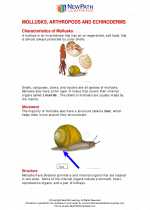 Mollusks, Arthropods and Echinoderms
Mollusks, Arthropods and Echinoderms  Activity Lesson
Activity Lesson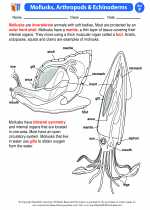 Mollusks, Arthropods & Echinoderms
Mollusks, Arthropods & Echinoderms  Worksheet/Answer key
Worksheet/Answer key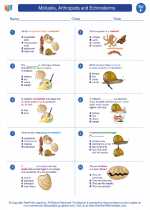 Mollusks, Arthropods and Echinoderms
Mollusks, Arthropods and Echinoderms  Worksheet/Answer key
Worksheet/Answer key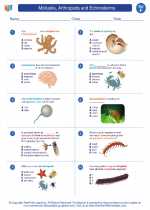 Mollusks, Arthropods and Echinoderms
Mollusks, Arthropods and Echinoderms  Worksheet/Answer key
Worksheet/Answer key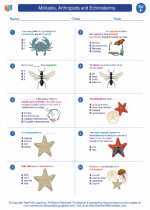 Mollusks, Arthropods and Echinoderms
Mollusks, Arthropods and Echinoderms  Worksheet/Answer key
Worksheet/Answer key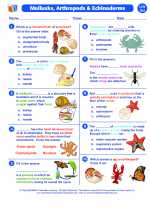 Mollusks, Arthropods and Echinoderms
Mollusks, Arthropods and Echinoderms  Vocabulary/Answer key
Vocabulary/Answer key Mollusks, Arthropods and Echinoderms
Mollusks, Arthropods and Echinoderms  Vocabulary/Answer key
Vocabulary/Answer key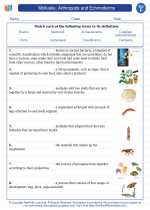 Mollusks, Arthropods and Echinoderms
Mollusks, Arthropods and Echinoderms  Vocabulary/Answer key
Vocabulary/Answer key Mollusks, Arthropods and Echinoderms
Mollusks, Arthropods and Echinoderms  Vocabulary/Answer key
Vocabulary/Answer key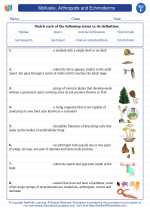 Mollusks, Arthropods and Echinoderms
Mollusks, Arthropods and Echinoderms  Vocabulary/Answer key
Vocabulary/Answer key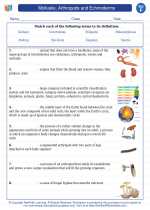 Mollusks, Arthropods and Echinoderms
Mollusks, Arthropods and Echinoderms  Vocabulary/Answer key
Vocabulary/Answer key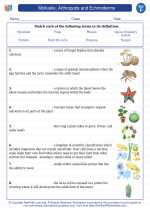 Mollusks, Arthropods and Echinoderms
Mollusks, Arthropods and Echinoderms  Vocabulary/Answer key
Vocabulary/Answer key Mollusks, Arthropods and Echinoderms
Mollusks, Arthropods and Echinoderms 

 Activity Lesson
Activity Lesson
 Worksheet/Answer key
Worksheet/Answer key
 Worksheet/Answer key
Worksheet/Answer key
 Worksheet/Answer key
Worksheet/Answer key
 Worksheet/Answer key
Worksheet/Answer key
 Vocabulary/Answer key
Vocabulary/Answer key
 Vocabulary/Answer key
Vocabulary/Answer key
 Vocabulary/Answer key
Vocabulary/Answer key
 Vocabulary/Answer key
Vocabulary/Answer key
 Vocabulary/Answer key
Vocabulary/Answer key
 Vocabulary/Answer key
Vocabulary/Answer key
 Vocabulary/Answer key
Vocabulary/Answer key

The resources above cover the following skills:
LIFE SCIENCE
From Molecules to Organisms: Structures and Processes